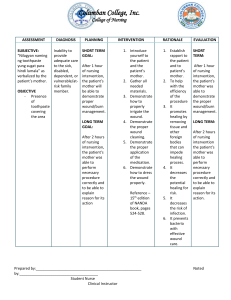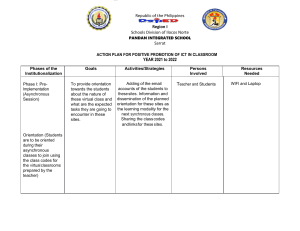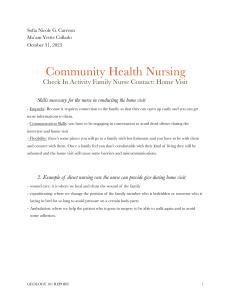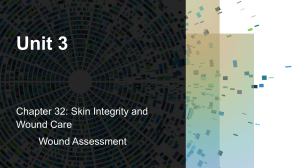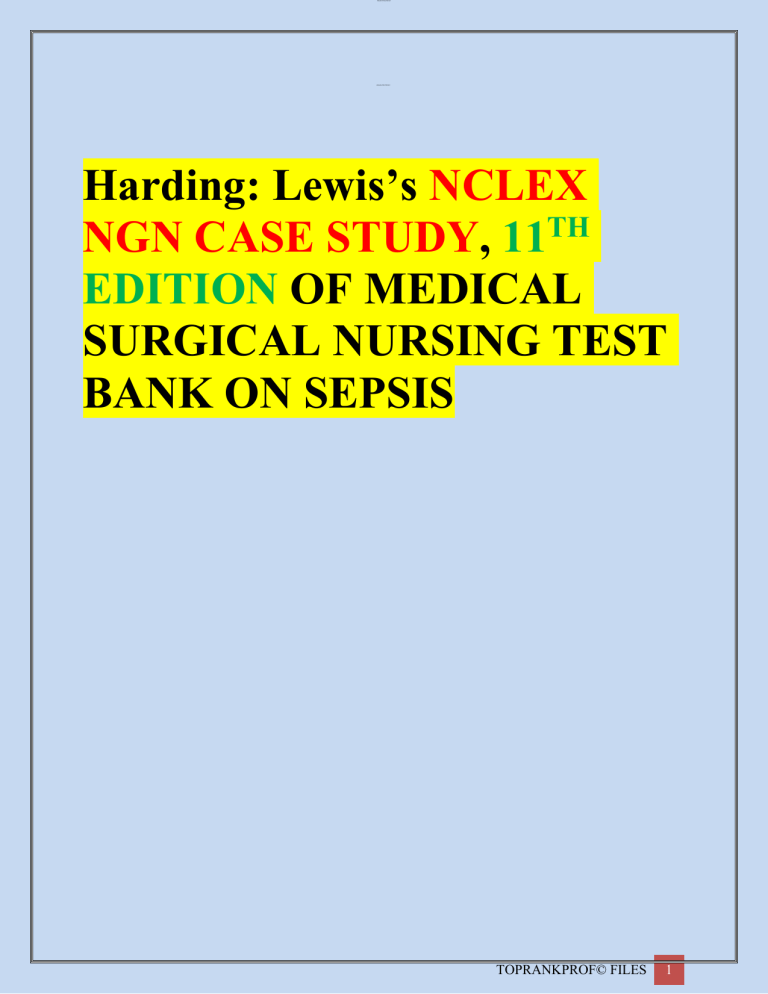
lOMoAR cPSD| 27322861 lOMoAR cPSD| 27322861 Harding: Lewis’s NCLEX NGN CASE STUDY, 11TH EDITION OF MEDICAL SURGICAL NURSING TEST BANK ON SEPSIS TOPRANKPROF© FILES 1 lOMoAR cPSD| 27322861 Harding: Lewis’s Medical-Surgical Nursing, 11th Edition NGN Case Study Title: Sepsis Scenario: A 73-year-old male was taken to the Emergency Department by ambulance because his wife found him sitting up in his recliner, awake but not responsive. He takes sitagliptin daily for type 2 diabetes mellitus and a daily multivitamin. A rapid assessment reveals the following: opens eyes when his name is called; otherwise keeps them closed. Does not follow instructions. Skin warm and flushed. Heart rhythm regular, rate 114; ECG shows sinus tachycardia. BP 96/52; respirations 24. Temperature 101.5°F (38.6°C). SPO2 96% on room air; lungs clear to auscultation bilaterally. Abdomen soft, nondistended, with normoactive bowel sounds in all quadrants. Trace edema noted on ankles and shins bilaterally. The patient has a large bandage on his right arm; his wife explained that he cut himself badly when gardening a few days ago and they wrapped it with a bandage to stop the bleeding. The wound on the right forearm is 3.2 cm long, 0.5 cm wide, and 0.2 cm deep, with redness around the wound and a moderate amount of yellowish drainage on the bandage. Laboratory results are listed below. The stroke team evaluated the patient using the NIH Stroke Scale; the evaluation was negative for a stroke. A STAT CT scan came back normal. Laboratory Results: TOPRANKPROF© FILES 2 lOMoAR cPSD| 27322861 Na 144 mEq/L K 4.9 mEq/L Glu 134 mg/dL BUN 22 mg/dL Creatinine 1.4 mg/dL Lactic acid 2.9 mg/dL Procalcitonin 0.6 ng.mL WBC 19.2 1000/mm3 Hgb 16 g/dL Hct 44% Platelet count 249,000 mm3 1. NGN Item Type: Highlighting/Enhanced Hot Spot Highlight or place a check mark next to the assessment findings that require follow-up by the nurse. Cognitive Skill: Recognize Cues TOPRANKPROF© FILES 3 lOMoAR cPSD| 27322861 Reference: Harding et al., Medical-Surgical Nursing, 11th ed., 2020, Ch. 66, pp. 1659, 1572. 2. NGN Item Type: Cloze Choose the most likely options for the information missing from the statement below by selecting from the list of options provided. The nurse recognizes that based on the patient’s history and diagnosis, he is currently at risk for complications, especially septic shock respiratory failure , acute kidney injury , and . Options Septic shock Fluid overload Respiratory failure Hypertensive crisis Coronary vessel occlusion Acute kidney injury TOPRANKPROF© FILES 4 lOMoAR cPSD| 27322861 Cognitive Skill: Analyze Cues Reference: Harding et al., Medical-Surgical Nursing, 11th ed., 2020, Ch. 66, pp. 1569, 1571, and 1579. Scenario: Within the hour, the patient is transferred to a step-down unit and the admitting nurse is reviewing orders for cultures and antibiotics, which include piperacillin-tazobactam and vancomycin. The patient is receiving intravenous normal saline at 150 mL/hour after receiving two 500 mL fluid boluses of normal saline in the emergency department. He is more awake but still confused and does not know where he is. He states that his right arm “hurts really bad” but he is unable to rate the pain on a 1 to 10 scale. Vital signs are: Temperature 101°F (38.3°C), pulse 100, respirations 22, BP 104/98. He is on oxygen 2 L/min per nasal cannula, and the latest SpO2 reading is 97%. He voided 500 mL of dark amber urine into a urinal. A wound care specialist will be coming in to assess the arm wound; the arm wound is loosely covered with a gauze dressing and is draining a small amount of yellowish fluid. 1. NGN Item Type: Cloze Based on the patient’s condition, the patient’s priority needs will be to prevent and Injury from falling pain . In addition, he will need interventions to prevent TOPRANKPROF© FILES 5 lOMoAR cPSD| 27322861 VTE , Skin Breakdown , diarrhea , and stress ulcer . Options for 1 Options for 2 Musculoskeletal weakness Diarrhea Pain Stress ulcers Injury from falling Skin breakdown Hypoxia Fluid volume deficit Venous thromboembolism (VTE) 2. NGN Item Type: Matrix Use an X for the nursing actions listed below that are Indicated (appropriate or necessary), Contraindicated (could be harmful), or Nonessential (makes no difference or not necessary) for the patient’s care at this time. Only one selection can be made for each nursing action. Nursing Action Indicated Contraindicated Nonessential TOPRANKPROF© FILES 6 lOMoAR cPSD| 27322861 Start the antibiotic before X initiating other orders. Obtain blood cultures before X beginning the antibiotic. Change the arm dressing every X 2 hours. Administer pain medication. x Measure intake and output X every 1 to 2 hours. Apply soft restraints to prevent X falls. Scenario: The wound care specialist assessed the patient’s arm wound and ordered wound cultures and indicates that the wound will heal by secondary intention. An alginate dressing is applied, with orders to change it twice daily. After 3 days, the patient is less confused but unsteady on his feet when assisted to the chair. He states that he does not like hospital food. TOPRANKPROF© FILES 7 lOMoAR cPSD| 27322861 1. NGN Item Type: Extended Drag and Drop Use an X to indicate which actions in the left column would be implemented by the nurse. Note that not all nursing actions will be used. Nursing Actions Implementation Maintain fall precautions. x Assess and document the wound x characteristics with every dressing change. Obtain a wound culture of the exudate from the wound. Clean the wound with povidone-iodine before applying a new dressing. Replace the dressing if it becomes saturated x with drainage. Observe the wound for signs of delayed x wound healing. TOPRANKPROF© FILES 8 lOMoAR cPSD| 27322861 Request a nutritional consult for parenteral nutrition. Cognitive Skill: Take Action Reference: Harding et al., Medical-Surgical Nursing, 11th ed., 2020, Ch. 5, p. 71; Ch. 11, pp. 164, 167–168. 2. NGN Item Type: Matrix For each assessment finding, use an X to indicate whether the interventions were Effective (helped to meet expected outcomes), Ineffective (did not help to meet expected outcomes), or Unrelated (not related to the expected outcomes). Assessment Finding States that his pain level is a 4 1 Effective Ineffective Unrelated X hour after pain medication; previously stated it was an 8. TOPRANKPROF© FILES 9 lOMoAR cPSD| 27322861 Systolic blood pressure remains X greater than or equal to 90 mm Hg. Gets out of bed by himself to X walk in the room. Denies difficulty with urination. No drainage noted from the X X wound. Wound measures 3 cm long by 0.4 cm wide by 0.1 cm deep. Redness decreased. Patient eats 25% of his meals and X 50% of the supplement provided. TOPRANKPROF© FILES 10
